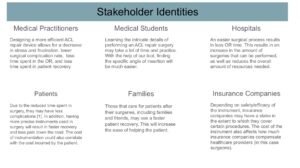
For more information regarding stakeholders, please see our expert interviews.
Stakeholder Perspectives
Through interviews with surgeons and extensive outside research, we learned that there is a need for ACL surgical instruments to be improved upon in terms of time, cost, and efficiency through the development of more specific tools such as LET drill guides. Surgeons communicated with us that there is a need for a tool which decreases the risk of tunnel conflict during an LET surgery.
Through interviews with physical therapists and athletic trainers, we learned that there is a need for faster and more efficient recovery. The physical therapists that we spoke to discussed how overwhelmed with patients they can be at times. This leads to less one on one care and attention from the physical therapist. Less recovery time will lead to more time for the physical therapist to work with each individual patient. Studies suggest that a less invasive, and more specific device could equate to less surgical complications and therefore, quicker recovery post surgery.
After doing research on who specifically suffers the most from an ACL tear, we found that females are two to eight times more likely to suffer from an ACL tear than males. It is theorized that this is because females have anatomical differences that make them more prone to this injury [1]. Additionally, ACL injuries are common in sports such as skiing, soccer, and basketball, which require sudden changes in direction, and football, which is a high impact sport [2].
Our Assumptions
We are assuming that surgeries would be more time effective, and therefore, more cost-effective as well as reduce complications while using our tool. Surgeons, nurses, medical students, and hospitals will benefit from these improvements. Another assumption we are making is that most patients need post-surgery care, such as PT and care from friends and family, and that recovery times need to be improved. We are also assuming that the patient is using insurance and that it is broadly accepted that there is a need to reduce medical bills. Patients will also benefit from a decrease in surgical time, in complications, cost, and in recovery time. Lastly, we are assuming that the need for improved surgical tools is a general belief amongst surgeons, although we only interviewed a very small sample size. As engineers, it is important to design optimally and aim to create a product that will serve different types of people. As a result, It is crucial that we understand how our unconscious biases and assumptions can influence our research and design decision. The risk of making these assumptions is that we may be addressing a need that is not going to benefit as many groups as we had imagined.
[1] https://www.yalemedicine.org/news/sports-injuries-gender#:~:text=According%20to%20research%2C%20an%20ACL,Gardner%20says.